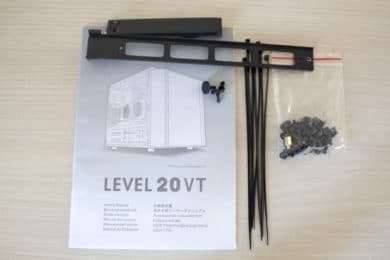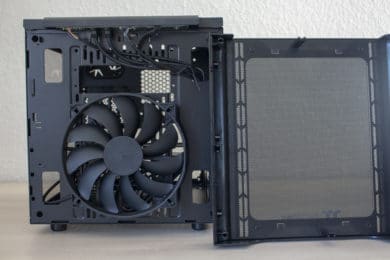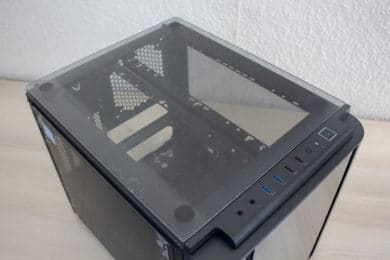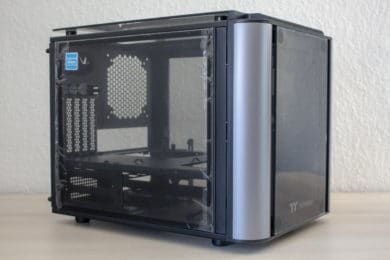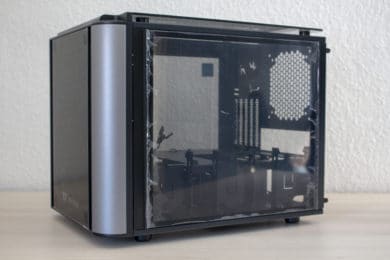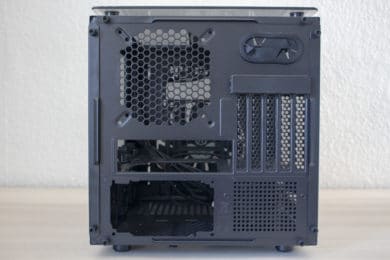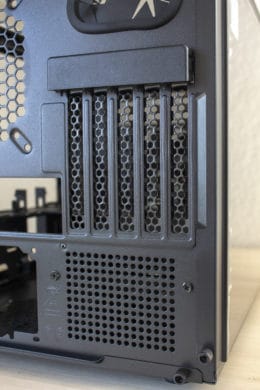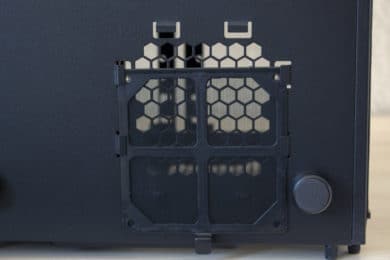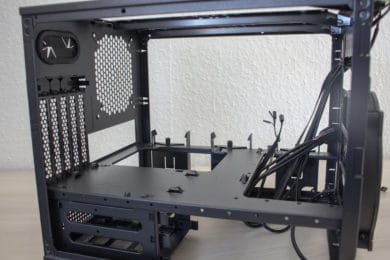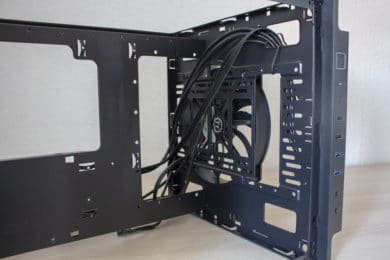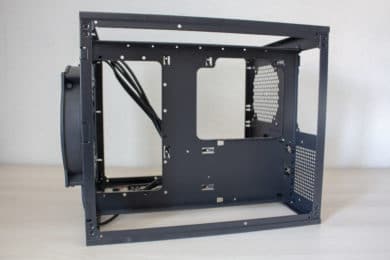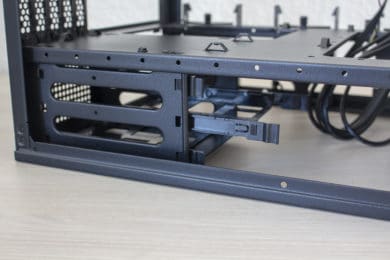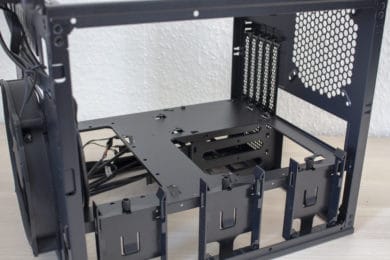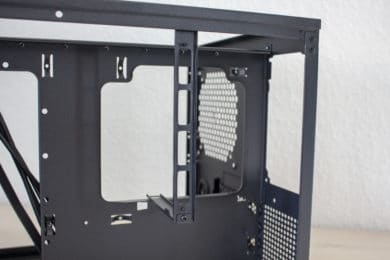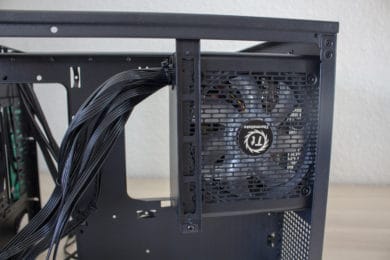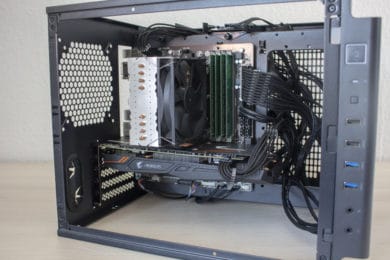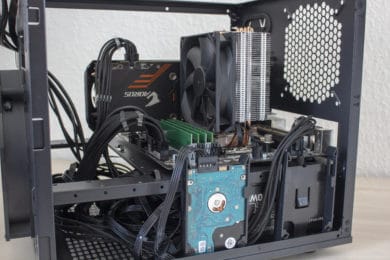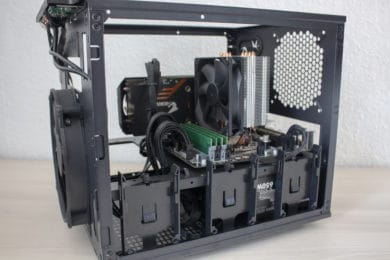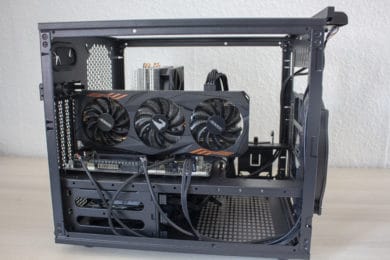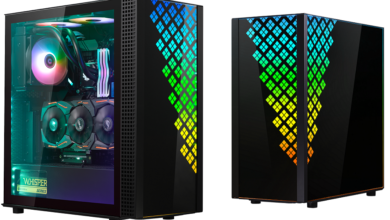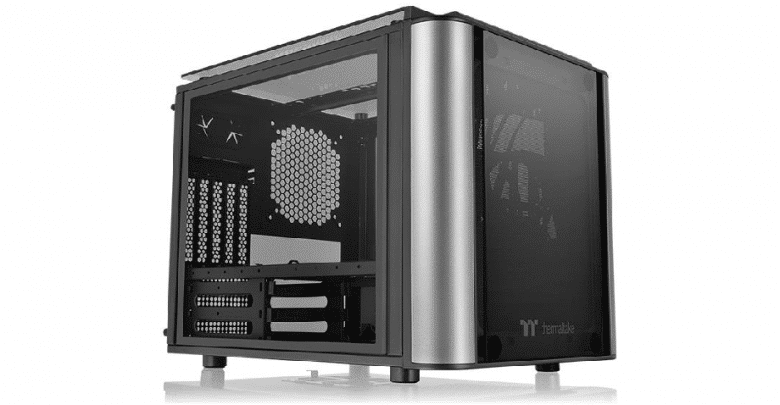
The manufacturer Thermaltake currently has various housing series on offer. Among them are the towers from the premium series “Level 20”. In August 2018, this series was extended by Level 20 VT, among other things. This is a so-called cube housing (cube) for µATX mainboards. It is only available in a black version with silver accents and currently costs € 119.99 *.
The manufacturer promotes the “Pocket Rocket” with premium workmanship, good airflow and outstanding compatibility for water cooling components. According to Thermaltake, all these features were packaged in a unique and space-saving housing with an ultra-modern design. Whether the Thermaltake Level 20 VT can do justice to these hymns of praise and how it performs in general, we will find out in this review for you.
Technical Details
| Model: | Thermaltake Level 20 VT |
| Housing type: | Cube |
| Dimensions: | 330 mm (W) x 348 mm (H) x 430 mm (D) |
| Weight: | 8.66 kg |
| Material: | Steel, plastic, tempered glass |
| Color: | Black |
| Front connections | 2x USB 3.0 Type-A, 2x USB 2.0, 1x speaker, 1x microphone |
| Drive bays: | 3x 3,5″ or 2,5″ (internal) 3x 2,5″ (internal) |
| Extension slots: | 5 |
| Form factors: | mATX, mini-ITX |
| Ventilation: | Front: 1x 200/ 2x 140/ 1x 120 mm Rear: 1x 140/ 1x 120 mm Lid: 2x 140/ 4x 120 mm bottom: 2x 120 mm |
| Radiators: | Front: 1x 240/ 1x 180/ 1x 140 mm Cover: 1x 280/ 2x 240/ 1x 180 mm Rear: 1x 120 mm |
| Max. CPU cooler height: | 185 mm |
| Max. Graphics card length: | 350 mm |
| Max. Power supply length: | 200 mm (with fan in bottom) |
| Cable management space: | not limited |
| Price: | € 119.99 * |
| Special features: | Dust filter, cable management, four glass side panels |
Scope of Delivery
The Thermaltake Level 20 VT comes well and safely packed in a brown cardboard box with black lettering and is wrapped in a soft polystyrene foam. Furthermore, the manufacturer has covered all four glass elements with an additional protective film to protect them from scratches. The supplied accessories were fastened in a transparent plastic bag inside the housing with a cable tie. This bag contains all important screws, a power supply holder, six black cable ties and an illustrated manual in several languages. In addition, the already pre-installed fan with a frame size of 200 mm is included in the scope of delivery.
Exterior Impression
The Thermaltake Level 20 VT is very conspicuous on the outside. The steel body is covered on four sides with tempered glass elements. This makes it look a bit like an aquarium at first glance. But let’s start in the front. This is characterized by a large tempered glass disc and was printed in the lower area with the name and logo of the manufacturer. The rest of the front panel consists of plastic and two silver accent strips, which are also made of plastic. To protect the interior from dust, there is also a dust filter behind the glass pane. However, this is made of a rather coarse mesh and probably only holds back the most necessary. The front panel can be pulled off with a powerful jerk and provides a view of the pre-installed 200 mm fan.
Like the front, the lid is dominated by a large tempered glass element. This element is mounted on a steel frame with a pull-off aid and is fastened to the rear with two knurled screws. In addition, the pane was lifted slightly with four standoffs. This creates a gap through which the warm air can pass from the inside to the outside. In the front area of the cover there is also the I/O panel pointing upwards. This was equipped with two USB 3.0 ports, two USB 2.0 ports, and two HD audio headers for headphones and microphone.
The left and right side parts are similar in construction to the glass element in the lid. The only difference, however, is that the side panels are flush with the body and there is no gap for air circulation.
A look at the back reveals another special feature of the cube housing. At level 20 VT the mainboard tray is mounted horizontally. The mounting position for the power supply unit and the HDD cage are located in a chamber below. Expansion cards are screwed outside the housing.
Also the bottom has a removable element, which was provided with a fine dust filter for the power supply unit and further fan openings. It’s a shame, however, that the additional fan opening in the floor doesn’t have a dust filter.
The general workmanship is good. There are no paint defects or sharp edges. In addition, all modular elements are flush and there are no conspicuous gap dimensions.
Internal impression
If you free the body from all side parts and the front panel, you strictly speaking get a frame with an internal volume of almost 50 litres. As mentioned in the previous section, the mainboard tray is horizontal at level 20 and has punched out spacers for the mainboard. In addition, there is a large cut-out for the subsequent mounting of CPU coolers with backplate. Unfortunately Thermaltake did not provide special openings for the cable management for the mainboard sled.
The power supply is placed below the mainboard level. In addition, there is an HDD cage for up to three 3.5″ or 2.5″ media. If this cage is not needed, it can also be dismantled by removing three screws. For those who want to use even more hard disks in the Thermaltake, there are three more frames for 2.5″ SSDs or HDDs on the right side. These are made of plastic and have a mechanism for tool-free fastening. Also here Thermaltake relies on a simple fastening with a knurled screw per frame.
In the upper area, the manufacturer has also added four rails with various holes. These serve as possible holding points for radiators when water cooling is installed. The rails are made of metal and the bracket looks solid.
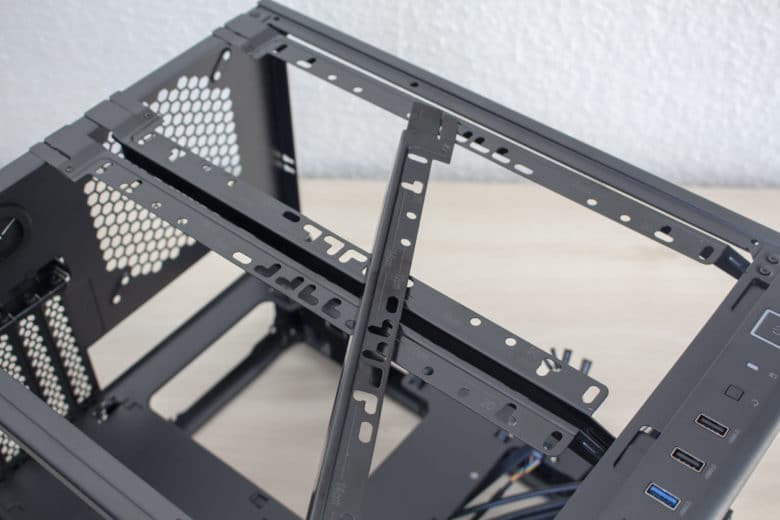
If you take a closer look at the body, you will soon notice that all sides are the same size. This makes it possible to exchange all side windows and the floor element. If you don’t like the horizontal position of the mainboard, you could rotate the body as well as 90 degrees. The I/O and front panels can also be remounted accordingly.

System Construction in Thermaltake Level 20 VT
Now we come to system installation. As hardware we use a Intel Xeon 1230v3 on a Gigabyte H87M-D3H with 16GB RAM. The Xeon is represented by a LC-Power Cosmo Cool LC-CC-120 cooled. A GTX 1060 6GB from Gigabyte AORUS* is responsible for the image output. The power supply is done by the non-modular Berlin Pro RGB 650W* with RGB fan. In order to enhance the cabling optically a little bit, single sleeved cable extensions from Phanteks.
Before the installation of all components can begin, it is recommended that all side panels, the radiator strips and the front panel are dismantled first. Then you have almost unrestricted access to the interior.
The power supply unit is mounted in the lower chamber. So that the PSU doesn’t just hang on the four screws on the back, Thermaltake also supplies a plug-in mounting frame. Here the instructions are a bit inaccurate and you had to experiment a bit to find the right mounting position.
Otherwise, the installation of all components ran smoothly. The Level 20 VT offers space for 350 mm long graphics cards and 185 mm high CPU coolers. Nothing stands in the way of the installation of current high-end components. But also representatives from the water cooling sector should have their joy with this Cube. Thus, up to three 240 mm radiators can be installed simultaneously in the interior.
After the installation and the subsequent wiring, however, we were still somewhat dissatisfied with the overall result. Due to the missing cable openings and the large free area behind the front fan, the cables could only be hidden insufficiently. This makes the interior look a little messy.
But if you leave out the cable extensions and put one or two cables under the motherboard, the overall result can be seen from all sides. The flat ribbon cables of the power supply were definitely an advantage here.
The installation of the data carriers is well solved. All trays and the HDD cage are modular and can be completely removed if required. The plastic frames are mounted in the HDD cage with built-in rubber rings for decoupling. These frames support the tool-free mounting of 3.5″ data carriers or the screwing of 2.5″ SSDs. The trays on the right side of the housing each support a 2.5″ device. Due to the one-sided screw connection, however, the installed data carrier wobbles back and forth a bit.
As with every review, the temperature test should of course not be missed. For this purpose, Prime95 and Furmark were run at a room temperature of 20 °C for 15 minutes and the CPUID HWMonitor was then used to determine the temperature of the processor and graphics card. The test was carried out in four different scenarios and shown in the following table.
Fan speed |
Temperature |
| CPU: 100%. Housing fan front: 100% |
CPU: 76 °C GPU: 70 °C |
| CPU: 100%. Case fan front: 100%. Case fan rear: 100% |
CPU: 71 °C GPU: 70 °C |
| without front panel CPU: 100%. Housing fan front: 100% |
CPU: 68 °C GPU: 68 °C |
| without front panel CPU: 100%. Case fan front: 100%. Case fan rear: 100% |
CPU: 66 °C GPU: 65 °C |
The test shows that the front panel has a negative effect at least with regard to the CPU temperatures and noticeably reduces the airflow. In addition, you can see that a rear fan installed later noticeably reduces the temperatures in the CPU area when the front panel is attached. If you are thinking about purchasing level 20 VT, then you should add at least one more fan to your shopping cart. But this cube case is still not an airflow miracle.
Conclusion of the Thermaltake Level 20 VT Review
One thing is clear with the Thermaltake Level 20 VT: it is a striking case in which you can show off your high-end components very well. The four tempered glass elements give you a good view of the innards from almost any position. But what should also be clear to any interested party before buying is the fact that the Level 20 VT with an internal volume of 50 litres is not exactly small and looks quite massive on the desk. The manufacturer’s designation “Pocket Rocket” is therefore somewhat misleading in our eyes. However, even the largest components and a potent water cooling system fit into this cube housing. Combine this with RGB elements and you get a well processed eye-catcher. But due to the restrictive front you should definitely invest in more fans and keep an eye on the temperatures.
With a price of € 119.99 * the Cube also has a lot of competition. These do not offer the same Cube format and no four glass elements, but the competitors are partly however more favorable and support besides ATX boards.
Thermaltake Level 20 VT
Workmanship
Structure
Features
Cooling
Value for Money
A real show case with lots of space and glass, but a limited airflow.



